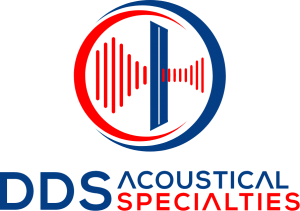The following are common laws and rules of thumb for noise mitigation that we use (and so can you) to understand and measure sound and noise levels.
Making a space 50% quieter means a 10 decibel (dB) noise reduction
Many customer come to us wanting to reduce the noise in a space and often confuse decibels for loudness. The reality is that for every 10db reduction you halve the noise. So when someone with a noise source of 80dB says they want to halve the noise to 40db, the correct statement would be reducing the 80db source to 70db to halve the noise.
Doubling the mass of a noise barrier, the Sound Transmission Class (STC) increases by approximately 5dB.
It makes sense that a denser barrier would prevent more sound transmission. In fact, it’s a law that for every doubling of the mass that there is a 5dB increase in the STC. As discussed previously, a 10db reduction equates to 50% less noise, so 5db is halfway and clearly noticeable.
Break the line of sight and double the height and length of a barrier at a noise source
When looking to reduce the transmission of noise with a barrier it is a rule of thumb that the barrier should be as close to the noise source as possible and be double the height and length of the noise source. This is particular relevant in exterior applications such as construction and outdoor sport facilities. If you can see a loud noise source, chances are you can hear it. If your barrier is the same height and width of a noise source, that noise will work its way around and you’ll still be able to hear it.
Sealing gaps and airways can greatly reduce sound transmission
When a customer approaches us with noise issues coming from another space, one of the first things we look for are gaps and airways leading into the area of concern. Gaps can be present in doorways, ceilings, ductwork, etc. By sealing these gaps we can cut down on sound transmitting into a space.
For every doubling in distance from a noise source +/- 6db (in an open field test)
According to the Inverse Square Law of Sound, it states that in an open field test (an area with no reflective surfaces or reverberation) that for every doubling of distance away from a noise source equates to – 6dB reduction. This is a way of understanding something we are already aware of on a basic level: that sound gets quieter as we travel away from the source.
Adding Noise sources (dB) is logarithmic, not additive
Whenever you have two or more noise sources in an area, you might assume that 45dB + 45dB = 90dB. In fact, decibels is logarithmic rather than additive. In the previous example the sound would be 250% louder!
The rule of thumb is that you only add two noise sources at a time and then continue down the line. The addition of noise sources is as follows:
- 0-1dB difference = +3dB to higher source
- 2-3db difference = +2dB to higher source
- 4-9db difference = +1db to higher source
- 10db or more difference = +0 to higher source
In the example of 45db + 45db the total sound would be 48db
Those are some of the basic rules of thumb for noise mitigation. If you have any questions or need help solving your noise problem, contact us!
